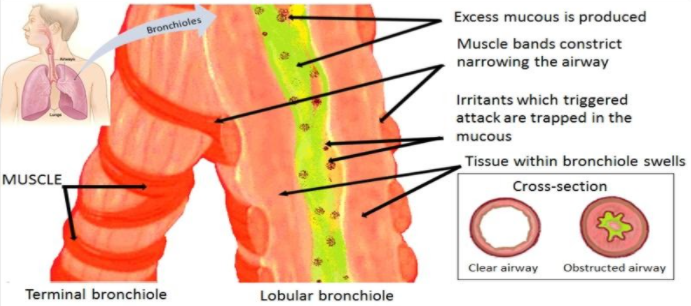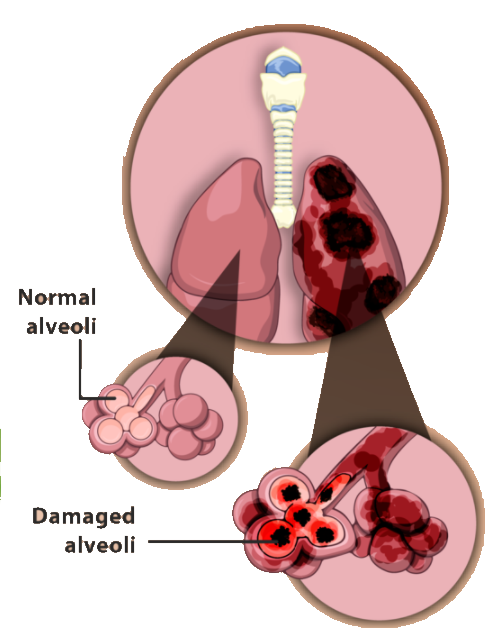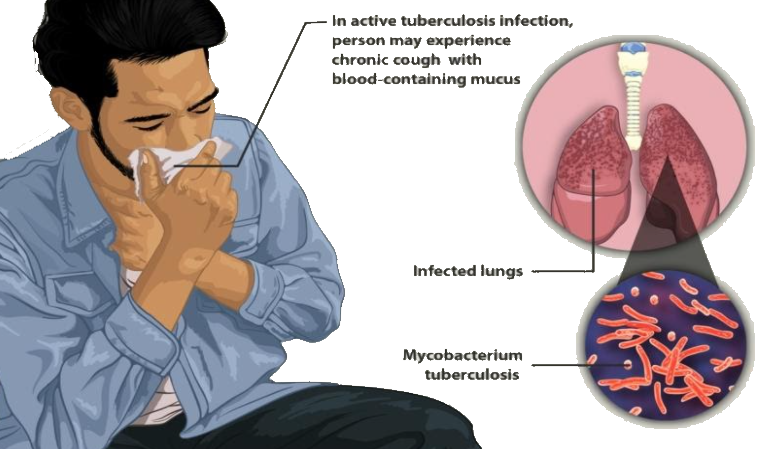
Describe disorders of the respiratory system.
Answer
438.1k+ views
2 likes
Hint: Respiratory disorders are the disorders that affect the lungs and other parts of the respiratory system. Respiratory disorders can be caused by smoking tobacco, by infection, by breathing in second-hand smoke of tobacco, asbestos, radon, or other forms of air pollution. Respiratory disorders vary from minor to major disorders. The study of respiratory disorders is called pulmonology.
Complete answer:
- Respiratory disorders are the pathological conditions affecting the tissues and organs that make difficulties in the exchange of gas in air-breathing animals.
- They include conditions of the respiratory tract including the bronchi, bronchioles, trachea, alveoli, pleurae, pleural cavity, and the muscles and the nerves of respiration.
- There are various respiratory disorders such as asthma, chronic obstructive pulmonary disease, Bronchitis, emphysema, tuberculosis, obstructive respiratory disorders, etc.
(a) Asthma:
It is a condition in which difficulty arises in the breathing of a person due to inflammation of the bronchi and bronchioles. Symptoms of asthma are shortness of breath, dry cough, and wheezing. Multiple factors that trigger an asthmatic attack are pollution, infection, allergic reactions, etc. Generally, asthma begins in childhood and goes on into adulthood. Some people at the age of 60 or 70 can develop asthma, this is known as adult-onset asthma.

(b) Chronic Obstructive pulmonary disease (COPD):
The term chronic obstructive pulmonary disease describes multiple respiratory disorders that cause breathlessness or affect normal exhalation. COPD is a serious disorder and the symptoms include shortness of breath and coughing up sputum i.e. mucus from the lungs. COPD is difficult to diagnose as it develops without any visible symptoms for a long time or sometimes the symptoms can be mistaken for the normal process of aging. One of the major causes of COPD is cigarette smoking.
(c) Bronchitis:
Chronic bronchitis is a form of COPD. Symptoms include coughing. Patients with this disorder usually have cough up sputum in the morning. This disease is treated with antibiotics.
(d) Emphysema:
Emphysema is another form of COPD and it is a serious respiratory disorder. The major cause of this disorder is cigarette smoking which damages the alveolar walls and decreases the respiratory surface. Patients with this disorder find difficulty in exhaling air from their lungs. In some cases, there is respiratory failure and the need for extra oxygen for breathing.

(e) Tuberculosis:
Tuberculosis is an infectious disease and it is caused by the bacterium Mycobacterium tuberculosis. Usually, the lungs get affected by tuberculosis but it can also affect other parts of the body. Tuberculosis spreads through the air when a patient with tuberculosis coughs, sneezes, speaks, or spits. Symptoms of TB are a chronic cough with blood in the sputum, weight loss, fever, and night sweating. If the disorder is not treated it can be fatal.

(f) Obstructive Respiratory Disorders:
Obstructive respiratory disorders occur due to the working conditions of a certain occupation. A lot of dust is released from the industries that involve stone-breaking or grinding which cannot be handled by the body's defence system. Continuous exposure to this dust causes inflammation which leads to fibrosis, resulting in lung damage.
Note: Respiratory disorders are disorders that affect the respiratory tract of the body. The organs and tissues of the respiratory system get infected. Respiratory disorder is a global problem. There is a reduction in life-threatening respiratory infectious disease and an increment in allergies and asthma. Respiratory disorders are caused by cigarette smoking, radon, asbestos, and air pollution. It is concluded that respiratory disorders are one of the most dangerous problems in the present era.
Complete answer:
- Respiratory disorders are the pathological conditions affecting the tissues and organs that make difficulties in the exchange of gas in air-breathing animals.
- They include conditions of the respiratory tract including the bronchi, bronchioles, trachea, alveoli, pleurae, pleural cavity, and the muscles and the nerves of respiration.
- There are various respiratory disorders such as asthma, chronic obstructive pulmonary disease, Bronchitis, emphysema, tuberculosis, obstructive respiratory disorders, etc.
(a) Asthma:
It is a condition in which difficulty arises in the breathing of a person due to inflammation of the bronchi and bronchioles. Symptoms of asthma are shortness of breath, dry cough, and wheezing. Multiple factors that trigger an asthmatic attack are pollution, infection, allergic reactions, etc. Generally, asthma begins in childhood and goes on into adulthood. Some people at the age of 60 or 70 can develop asthma, this is known as adult-onset asthma.

(b) Chronic Obstructive pulmonary disease (COPD):
The term chronic obstructive pulmonary disease describes multiple respiratory disorders that cause breathlessness or affect normal exhalation. COPD is a serious disorder and the symptoms include shortness of breath and coughing up sputum i.e. mucus from the lungs. COPD is difficult to diagnose as it develops without any visible symptoms for a long time or sometimes the symptoms can be mistaken for the normal process of aging. One of the major causes of COPD is cigarette smoking.
(c) Bronchitis:
Chronic bronchitis is a form of COPD. Symptoms include coughing. Patients with this disorder usually have cough up sputum in the morning. This disease is treated with antibiotics.
(d) Emphysema:
Emphysema is another form of COPD and it is a serious respiratory disorder. The major cause of this disorder is cigarette smoking which damages the alveolar walls and decreases the respiratory surface. Patients with this disorder find difficulty in exhaling air from their lungs. In some cases, there is respiratory failure and the need for extra oxygen for breathing.

(e) Tuberculosis:
Tuberculosis is an infectious disease and it is caused by the bacterium Mycobacterium tuberculosis. Usually, the lungs get affected by tuberculosis but it can also affect other parts of the body. Tuberculosis spreads through the air when a patient with tuberculosis coughs, sneezes, speaks, or spits. Symptoms of TB are a chronic cough with blood in the sputum, weight loss, fever, and night sweating. If the disorder is not treated it can be fatal.

(f) Obstructive Respiratory Disorders:
Obstructive respiratory disorders occur due to the working conditions of a certain occupation. A lot of dust is released from the industries that involve stone-breaking or grinding which cannot be handled by the body's defence system. Continuous exposure to this dust causes inflammation which leads to fibrosis, resulting in lung damage.
Note: Respiratory disorders are disorders that affect the respiratory tract of the body. The organs and tissues of the respiratory system get infected. Respiratory disorder is a global problem. There is a reduction in life-threatening respiratory infectious disease and an increment in allergies and asthma. Respiratory disorders are caused by cigarette smoking, radon, asbestos, and air pollution. It is concluded that respiratory disorders are one of the most dangerous problems in the present era.
Recently Updated Pages
Master Class 11 Economics: Engaging Questions & Answers for Success

Master Class 11 Business Studies: Engaging Questions & Answers for Success

Master Class 11 Accountancy: Engaging Questions & Answers for Success

Express the following as a fraction and simplify a class 7 maths CBSE

The length and width of a rectangle are in ratio of class 7 maths CBSE

The ratio of the income to the expenditure of a family class 7 maths CBSE

Trending doubts
State and prove Bernoullis theorem class 11 physics CBSE

What are Quantum numbers Explain the quantum number class 11 chemistry CBSE

Write the differences between monocot plants and dicot class 11 biology CBSE

1 ton equals to A 100 kg B 1000 kg C 10 kg D 10000 class 11 physics CBSE

State the laws of reflection of light

In northern hemisphere 21st March is called as A Vernal class 11 social science CBSE




